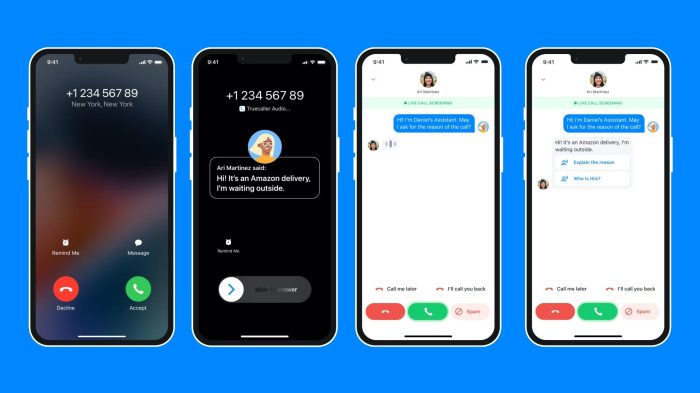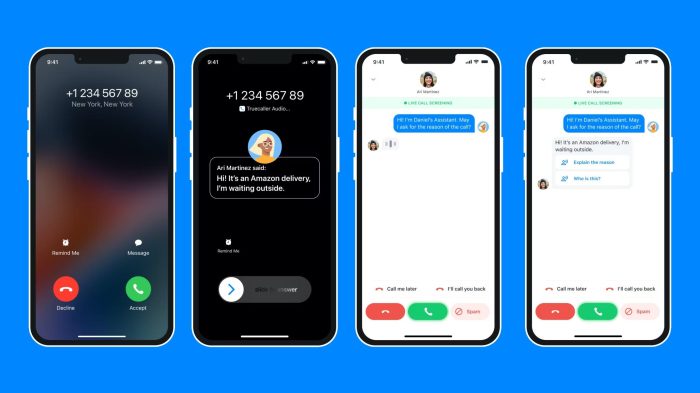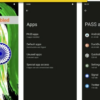Truecaller AI Microsoft Azure Voice Assistant: a powerful new voice assistant integration promises to revolutionize how we interact with technology. Imagine a future where your phone calls, customer service interactions, and even marketing campaigns are handled with unprecedented efficiency and accuracy by a combination of Truecaller’s AI and Microsoft Azure’s voice assistant capabilities. This integration promises a more personalized and intuitive user experience, but what exactly are the implications?
This exploration delves into the technical aspects, potential use cases, and even the security considerations of this ambitious project. From the intricacies of voice recognition and natural language processing to the critical issues of data security, we’ll examine all facets of this innovative voice assistant. Understanding the strengths and weaknesses of this integration is crucial for grasping its full potential and possible impact on various industries.
Introduction to Truecaller AI and Microsoft Azure Voice Assistant Integration
Truecaller, a leading caller ID and communication app, is increasingly leveraging artificial intelligence (AI) to enhance user experience and streamline communication. This integration with Microsoft Azure Voice Assistant promises to revolutionize how we interact with technology through voice commands. The potential benefits for users are substantial, ranging from simplified call management to personalized communication experiences.The integration of Truecaller’s AI with Microsoft Azure Voice Assistant will empower users to interact with their calls and communication in a more intuitive and efficient manner.
This will manifest in features that allow for voice-activated call routing, identification, and management. Truecaller’s AI, with its advanced call analysis and identification capabilities, will be coupled with Azure Voice Assistant’s robust voice recognition and natural language processing (NLP) to create a powerful, user-friendly platform.
Truecaller AI Capabilities
Truecaller’s AI is adept at identifying callers, analyzing call patterns, and filtering unwanted calls. It leverages machine learning algorithms to continuously improve its accuracy in recognizing and categorizing calls, providing users with a more personalized and secure communication experience. This AI can analyze call data to understand user preferences, potentially anticipating and proactively managing calls based on past interactions.
Microsoft Azure Voice Assistant Capabilities
Microsoft Azure Voice Assistant is a powerful platform for voice-based interactions. It offers a comprehensive suite of tools for voice recognition, natural language understanding, and speech synthesis. This robust platform allows for the development of sophisticated voice-activated applications. By integrating with Truecaller AI, the assistant will not only recognize and process voice commands but also interpret the context of the call, ensuring accurate and efficient responses.
Truecaller’s AI and Microsoft Azure’s voice assistant are fascinating technologies, but I’m also intrigued by how these advancements relate to broader environmental concerns. For example, understanding how geological time scales affect our current climate change crisis is crucial, as explored in Marcia Bjornerud’s insightful work on timefulness, geology, and climate change marcia bjornerud timefulness geology climate change environment.
Ultimately, these technological innovations could potentially offer solutions to environmental challenges, mirroring the broader implications of these intricate systems.
Integration Functionalities
The integration of Truecaller AI with Microsoft Azure Voice Assistant will result in a seamless voice-based communication experience. Users will be able to perform tasks such as blocking calls, forwarding calls, and even scheduling calls through voice commands. This will potentially enhance the user experience, particularly for individuals with busy schedules or those who prefer voice interaction over manual processes.
Key Features and Functionalities
This table Artikels the potential key features and functionalities of the integrated system:
| Feature | Truecaller AI | Microsoft Azure Voice Assistant |
|---|---|---|
| Voice Recognition | Identifies caller voice patterns, improving call accuracy | Provides accurate and reliable voice recognition for user commands |
| Natural Language Processing | Understands the intent behind calls, classifying and filtering | Interprets user voice commands and translates them into actionable steps |
| Call Routing | Analyzes call patterns to route calls to appropriate destinations based on user preferences | Facilitates call routing based on voice commands, ensuring efficient call management |
| Call Filtering | Identifies and filters spam or unwanted calls based on analysis of call data | Allows users to control call routing and filtering through voice commands |
Potential Use Cases and Applications: Truecaller Ai Microsoft Azure Voice Assistant
The integration of Truecaller AI with Microsoft Azure Voice Assistant opens up a wealth of possibilities for enhancing user experiences across various industries. This powerful combination leverages the strengths of both platforms to create intuitive and efficient voice-based solutions. The integration promises a seamless transition between human interaction and AI-powered assistance, streamlining tasks and improving overall user satisfaction.
Customer Service Enhancements
Truecaller AI’s ability to understand and interpret human language, combined with Azure Voice Assistant’s voice interaction capabilities, can revolutionize customer service. This integration allows for more accurate and efficient resolution of customer queries. For example, a customer service representative can use the voice assistant to quickly access relevant information about a customer’s account, such as order history or past interactions.
This ensures faster resolution times and a more personalized experience. This combination can handle complex queries, routing calls to the appropriate agents, and providing pre-emptive solutions, thereby reducing wait times and improving customer satisfaction.
Sales and Marketing Optimization
The integration can be a powerful tool for sales and marketing teams. AI-powered insights from Truecaller can help identify potential customers, personalize outreach, and track campaign performance. For instance, the voice assistant can schedule calls, send customized messages, and track responses, effectively automating and optimizing sales and marketing efforts. A personalized sales pitch based on a customer’s profile and past interactions can greatly increase conversion rates.
Improved User Experience Across Industries
The seamless integration of Truecaller AI and Microsoft Azure Voice Assistant can transform user experiences in various industries. Imagine a customer service scenario where a customer calls in with a technical issue. The voice assistant can quickly understand the problem, gather necessary information, and either resolve it immediately or route the call to a human agent with the relevant expertise.
This approach improves efficiency and provides a more satisfactory experience for both customers and businesses.
Potential Use Cases Table
| Use Case | Target Users | Benefits |
|---|---|---|
| Customer Support | Businesses | Reduced response times, improved accuracy in handling queries, increased customer satisfaction, and efficient routing of calls to the appropriate agents. |
| Sales Lead Generation | Sales Teams | Automated lead qualification, personalized outreach based on customer profiles, and improved lead conversion rates. |
| Marketing Campaign Management | Marketing Teams | Automated campaign scheduling, personalized messaging, and tracking of campaign performance. |
| Personalized Customer Interactions | Both Businesses and Customers | Improved customer experience, increased efficiency, and more streamlined interactions. |
Technical Aspects of Integration
Integrating Truecaller AI and Microsoft Azure Voice Assistant presents several technical challenges and considerations. Successfully bridging these two powerful platforms hinges on a meticulous understanding of their respective functionalities and limitations. This requires careful planning and execution to ensure seamless data exchange and robust security.
API Interactions and Data Exchange Protocols
The integration relies heavily on the APIs provided by both Truecaller AI and Microsoft Azure Voice Assistant. Understanding the structure and capabilities of these APIs is crucial. Successful data exchange necessitates adherence to the defined protocols, ensuring data integrity and efficient communication. Truecaller AI likely offers APIs for accessing its AI-powered functionalities, such as call analysis and intent recognition, while Microsoft Azure Voice Assistant APIs handle voice recognition, natural language understanding, and text-to-speech.
These APIs define the format for requests, responses, and data structures. For example, a request from the Voice Assistant to Truecaller AI might include the transcribed audio, and Truecaller AI would respond with its analysis, such as identifying the caller’s intent or emotional state. The data exchange protocols should be standardized to ensure interoperability and prevent errors.
Security Implications
Security is paramount in any integration involving sensitive data, such as voice recordings and personal information. Implementing robust security measures is essential to protect user data from unauthorized access and malicious attacks. Data encryption throughout the transmission and storage process is critical. Authentication mechanisms should be in place to verify the identity of both Truecaller AI and Microsoft Azure Voice Assistant.
This includes secure token exchange and appropriate access controls to limit the scope of authorized operations. Furthermore, adherence to industry best practices for data security, such as the Payment Card Industry Data Security Standard (PCI DSS), is recommended.
Data Flow Diagram
The following flowchart illustrates the data flow between Truecaller AI and Microsoft Azure Voice Assistant.
+-----------------+ +-----------------------+
| Microsoft Azure |--->| Truecaller AI |
| Voice Assistant | | |
+-----------------+ +-----------------------+
| | | +----------------+
| Audio | |--->| Analysis Result |
| Input | | +----------------+
| | | | Intent |
| | | | Emotion |
| | | | Caller ID |
| | | | Other Info |
+-----------------+
|
V
+-----------------------+
| Text/Data Output |
+-----------------------+
This diagram depicts the flow of audio data from the Voice Assistant to Truecaller AI for analysis.
The result, including intent, emotion, and other details, is then passed back to the Voice Assistant for further processing and response generation.
Technical Challenges
Integrating these services may present various technical challenges. Differences in data formats and communication protocols could require significant effort in data transformation. Ensuring real-time responsiveness, particularly in call-handling scenarios, is another crucial aspect. The complexity of natural language processing and intent recognition in both systems needs careful consideration. Potential issues could arise from variations in language support and accent recognition, especially when dealing with diverse user bases.
Data Security and Privacy Concerns

Integrating Truecaller AI with Microsoft Azure’s voice assistant introduces new dimensions of data handling and raises crucial concerns about security and user privacy. The sensitive nature of user voice data and the potential for unauthorized access necessitates meticulous attention to these concerns. This section explores potential risks, mitigation strategies, and best practices for protecting user information.
Potential Data Security Risks
Protecting user data is paramount when integrating AI systems. The potential for data breaches, unauthorized access, and misuse of personal information necessitates a comprehensive security framework. Compromised voice data could lead to identity theft, financial fraud, or privacy violations. Furthermore, the storage and processing of user voice data raise ethical concerns, particularly regarding potential bias in algorithms and the need for transparency.
Mitigation Strategies
Implementing robust security measures is essential to address the potential risks Artikeld above. These strategies are vital for maintaining user trust and confidence in the system.
- Encryption: Encrypting voice data both in transit and at rest is crucial. End-to-end encryption ensures only authorized parties can access the data, preventing unauthorized interception or manipulation. Advanced encryption protocols like AES-256 should be employed. This protects user conversations and personal information from prying eyes, ensuring confidentiality and integrity.
- Access Controls: Implementing strict access controls is critical. Only authorized personnel should have access to user data, and their access should be limited to the specific data required for their tasks. Role-based access control (RBAC) can help define clear roles and permissions, reducing the potential for malicious actors to gain access to sensitive information.
- Data Minimization: Collecting only the necessary data is essential. Storing and processing unnecessary information increases the attack surface. Data minimization ensures that only the data required for the functionality of the voice assistant is collected, processed, and stored. This reduces the risk of exposure and helps maintain privacy.
- Regular Security Audits: Regular security audits and penetration testing can help identify vulnerabilities and weaknesses in the system’s security posture. These audits should assess the effectiveness of implemented security measures, including encryption, access controls, and data minimization. Continuous monitoring and improvement of the security system are key.
Best Practices for User Data Privacy
Transparency and user control are paramount in ensuring data privacy.
- Clear Data Privacy Policies: Clearly communicating data privacy policies to users is essential. These policies should Artikel how user data is collected, used, and protected. Users should understand their rights regarding their data, including the ability to access, correct, and delete their information.
- User Consent: Obtaining explicit user consent for data collection and usage is critical. Users should be informed about the specific purposes for which their data will be used and have the ability to opt out of certain data collection processes.
- Data Retention Policies: Establishing clear data retention policies is vital. These policies should define how long user data will be stored and under what circumstances it can be deleted. These policies should align with applicable data privacy regulations, such as GDPR or CCPA.
- Regular Data Security Updates: Regularly updating the system with the latest security patches and improvements is vital. This helps to address known vulnerabilities and enhance the overall security posture of the integration.
Security Risk Assessment and Mitigation Strategies
A comprehensive approach to data security necessitates a careful assessment of potential risks and the development of tailored mitigation strategies. This table summarizes potential risks and corresponding mitigation strategies.
| Risk | Mitigation Strategy |
|---|---|
| Data breaches | Implementing robust encryption, access controls, and regular security audits. Utilizing multi-factor authentication and strong password policies. |
| Unauthorized access | Employing strict access controls, role-based access management (RBAC), and regular security audits. Implementing strong password policies and multi-factor authentication. |
| Malicious use of voice data | Developing AI models that are robust against adversarial attacks and employing anomaly detection to identify suspicious activity. Implementing strict data minimization policies. |
| Privacy violations | Creating clear data privacy policies, obtaining user consent, and ensuring compliance with relevant data privacy regulations. Implementing data anonymization techniques where appropriate. |
Competitive Analysis and Differentiation

The Truecaller AI integration with Microsoft Azure Voice Assistant presents a compelling opportunity, but success hinges on its ability to stand out in a crowded market. A strong competitive analysis is crucial to identifying potential strengths and weaknesses, allowing Truecaller to tailor its offering and target specific user needs. Understanding the competitive landscape will enable Truecaller to craft a compelling value proposition.
Truecaller’s AI and Microsoft Azure’s voice assistant are fascinating tech advancements. Thinking about how these innovations might affect our daily lives, I was reminded of the passing of Peter Mayhew, the iconic Chewbacca from Star Wars’ Empire Strikes Back and Return of the Jedi. This incredible actor’s legacy reminds us of the powerful impact of technology and the lasting impact of those who shape our cultural experiences.
Still, I’m back to thinking about how the Truecaller AI and Microsoft Azure voice assistant might enhance our communication in the future.
Comparative Analysis of AI-Powered Voice Assistants
Understanding the strengths and weaknesses of competitors is paramount to positioning Truecaller AI effectively. A comparative analysis allows for a clear picture of the existing market, identifying potential gaps and areas for innovation. This analysis will also inform the development of targeted marketing strategies and product development.
Truecaller’s AI and Microsoft Azure’s voice assistant are pretty cool, right? But have you considered the warranty on your solar batteries? Understanding the fine print is crucial, and thankfully, everything you need to know about your solar battery’s warranty is a great resource. It’s all about ensuring your investment is protected, which ultimately benefits your whole system, including those innovative voice assistants.
Knowing your solar battery’s warranty can help you avoid costly repairs down the road, just like you’d want to avoid unwanted calls with the best AI features.
| Feature | Truecaller AI | Competitor A | Competitor B |
|---|---|---|---|
| Voice Recognition Accuracy | Expected to be highly accurate, leveraging Azure’s advanced speech recognition technology, with potential for continuous improvement through machine learning. | High accuracy, but reported instances of misinterpretations in complex or noisy environments. | Excellent accuracy, particularly in controlled environments, but potentially less robust in noisy or accented speech. |
| Natural Language Understanding | Capable of understanding nuanced language and context, integrating Truecaller’s extensive contact database for more intelligent interactions. | Strong understanding of basic commands, but struggles with complex requests or queries requiring contextual awareness. | Excellent understanding of spoken language, including complex inquiries, but might lack contextual understanding of user interactions beyond immediate queries. |
| Integration with Existing Services | Seamless integration with Truecaller’s existing platform, including contact management, call logs, and potentially other services. | Limited integration options, primarily focused on basic functionalities. | Good integration with calendar and other applications, but potential limitations in connecting to specific third-party services. |
| Data Security and Privacy | Adherence to stringent Microsoft Azure security protocols and Truecaller’s established data privacy standards. | Documented data breaches in the past raise concerns about data security. | Compliant with data protection regulations but reported issues with transparency regarding data handling. |
| Pricing Model | To be determined, potentially tiered pricing based on usage or features. | Subscription-based model with varying price points depending on features and usage. | Free basic tier with premium features available at a subscription cost. |
Unique Strengths and Weaknesses of the Integration
Truecaller AI’s unique strengths lie in its ability to leverage Truecaller’s vast contact database for contextually aware interactions and its integration with the established Truecaller platform. This provides a significant advantage over competitors lacking similar depth. However, the integration’s weakness may lie in the initial learning curve for users transitioning from other voice assistant platforms, requiring careful user experience design to mitigate this.
Differentiation Strategies
The integration’s differentiation hinges on the unique blend of Truecaller’s contact data and Microsoft Azure’s voice assistant capabilities. Highlighting these strengths in marketing materials will be crucial to attracting users. Also, offering personalized experiences tailored to users’ individual needs and preferences will be a key differentiating factor. Early adopters and beta testing can provide valuable insights for optimizing the user experience.
Future Trends and Innovations
The integration of Truecaller AI with Microsoft Azure Voice Assistant marks a significant step forward in conversational AI. However, the technological landscape is constantly evolving, and understanding future trends is crucial for maximizing the integration’s potential and staying ahead of the curve. This section explores the exciting developments that could reshape the future of this integration and shape its impact on users.
Advancements in Conversational AI
Natural Language Processing (NLP) continues to improve, enabling voice assistants to understand and respond to more complex and nuanced user requests. This will translate into more sophisticated interactions with the Truecaller AI and Microsoft Azure Voice Assistant integration. For example, voice assistants can now handle more conversational turns, understand context better, and even infer user needs. This improvement is crucial for the integration’s success, allowing for more natural and efficient communication.
Furthermore, the ability to learn and adapt to individual user preferences will lead to a more personalized experience.
Emerging Technologies for Enhanced Integration
Several emerging technologies hold the potential to significantly enhance the capabilities of the Truecaller AI and Microsoft Azure Voice Assistant integration. These technologies include:
- Multimodal Interaction: Voice assistants are moving beyond solely audio input. The integration could leverage visual cues, such as facial expressions or gestures, to enhance understanding and provide a more comprehensive user experience. This could, for example, allow the voice assistant to better interpret user emotions during calls, leading to more empathetic responses.
- Contextual Awareness: Integrating real-time data sources, such as location, calendar appointments, and user profiles, can create a richer context for the voice assistant. For instance, if a user is calling from a specific location and the context is aware of a scheduled appointment, the voice assistant could offer relevant information or proactively suggest actions.
- Improved Speech Recognition: Continuous advancements in speech recognition technology will lead to more accurate and reliable transcription of conversations. This improvement will lead to greater efficiency and precision in the Truecaller AI’s ability to identify and classify calls.
Potential for Further Development and Innovation, Truecaller ai microsoft azure voice assistant
The potential for future development and innovation within this integration is substantial. Beyond enhancing existing features, the integration could explore entirely new avenues. For example:
- Automated Customer Service: The integration could be used to automate customer service tasks, such as answering frequently asked questions or routing calls to the appropriate agents. This could drastically reduce response times and improve customer satisfaction.
- Enhanced Security Features: As the integration handles sensitive data, enhanced security measures, including biometrics and advanced authentication protocols, will be crucial for maintaining user trust.
- Integration with Other Platforms: Further integration with other platforms, such as calendar applications, social media, and other communication tools, could expand the integration’s utility and create more seamless user experiences. Imagine the assistant seamlessly managing calls and appointments based on user calendars.
Possible Future Extensions and Enhancements
Several potential extensions and enhancements could expand the integration’s utility and create new use cases. These include:
- Personalized Recommendations: The voice assistant could provide personalized recommendations based on user behavior and preferences. For example, if a user frequently calls a specific business, the voice assistant could suggest relevant information about that business.
- Predictive Analysis: The integration could analyze call patterns and user interactions to predict potential issues or needs. This proactive approach could help users avoid problems and improve their overall experience.
- Multilingual Support: Expanding support to more languages will make the integration accessible to a broader user base and facilitate global communication.
User Interface and User Experience (UI/UX) Design
The success of the Truecaller AI integration with the Microsoft Azure Voice Assistant hinges significantly on a user-friendly interface. A well-designed UI/UX will encourage user adoption and maximize the value derived from the enhanced voice assistant capabilities. This section delves into the critical aspects of designing an intuitive and engaging interface for this integration.
The user interface must seamlessly blend the functionalities of Truecaller AI with the existing capabilities of the Microsoft Azure Voice Assistant. This requires a thoughtful consideration of user interaction patterns and navigation flows to ensure a smooth and intuitive experience. The design should prioritize simplicity and clarity, minimizing cognitive load for the user.
User Interaction Patterns
Understanding how users will interact with the integrated voice assistant is paramount. Users should be able to initiate calls, send messages, and access Truecaller’s features using natural language commands and voice prompts. The system should be able to interpret and respond to user input accurately and efficiently, ensuring minimal frustration and maximizing user satisfaction.
Navigation Flows
The navigation flow should be intuitive and consistent. Users should be able to easily navigate between different functionalities, such as placing calls, checking call logs, and accessing Truecaller’s contact database. A clear hierarchy of menus and options, combined with visual cues and feedback, is crucial for seamless navigation.
Intuitive and Engaging User Experiences
Examples of intuitive and engaging user experiences include:
- Voice-activated call initiation: Users should be able to initiate calls with natural language commands like “Call John Smith” or “Call the emergency number.” The system should provide confirmation and clear feedback on the call status.
- Visual call logs: A visual call log should display caller information, call duration, and call outcome. This should be easily searchable and filterable, allowing users to quickly access relevant information.
- Contextual assistance: The voice assistant should be able to provide relevant context-aware assistance. For example, if a user is calling a contact from their frequently contacted list, the assistant could proactively display their contact information.
Mockup of the User Interface
The following mockup illustrates a potential user interface design for the integrated system:
| Screen Element | Description |
|---|---|
| Call Initiation Bar | A prominent bar at the top of the screen, allowing users to initiate calls using voice commands or by selecting a contact from the contact list. The bar would also display call status information (e.g., call in progress, call ended). |
| Contact List | A scrollable list of contacts, with a search bar for quick access to contacts. The list should display relevant contact information (name, number, call history). |
| Call Log | A visual representation of recent calls, allowing users to review call details (date, time, duration, caller ID). The log should be easily filterable and sortable. |
| Voice Input/Output Panel | A panel dedicated to voice input and output, allowing users to interact with the voice assistant using voice commands. Visual feedback (e.g., loading indicators) should be provided during voice processing. |
“A well-designed UI/UX is critical to ensuring that users readily adopt and utilize the enhanced voice assistant capabilities.”
The mockup highlights key interaction points, such as call initiation, contact selection, and call log review. A consistent design language, using appropriate colors, typography, and icons, would further enhance the user experience.
Final Conclusion
In conclusion, the Truecaller AI Microsoft Azure Voice Assistant integration presents a compelling vision for the future of voice-activated technology. While technical challenges and security concerns are inherent in any new technology, the potential benefits for enhanced user experience, streamlined workflows, and improved efficiency are substantial. The integration’s ability to revolutionize industries from customer service to sales and marketing is exciting, and we look forward to seeing how this innovation evolves and shapes the future of communication.






